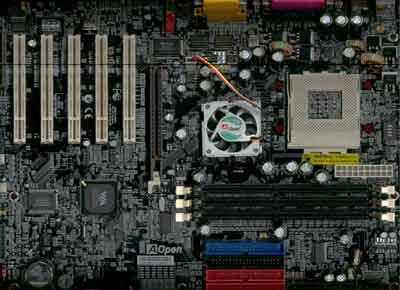VIA KT266A Motherboard Roundup - January 2002
by Mike Andrawes on January 18, 2002 4:48 AM EST- Posted in
- Motherboards
AOpen AK77 Plus
|
AOpen AK77 Plus |
|
|
CPU
Interface
|
Socket-A
|
|
Chipset
|
VT8366A
North Bridge
VT8233 South Bridge |
|
Form
Factor
|
ATX
|
|
Bus
Speeds
|
100
- 248MHz (in 1MHz increments)
|
|
Core
Voltages Supported
|
1.100
- 1.850V (in 0.025V increments)
|
|
I/O
Voltages Supported
|
Not
Configurable
|
|
DRAM
Voltages Supported
|
Not
Configurable
|
|
Memory
Slots
|
3
184-pin DDR DIMM Slots
|
|
Expansion
Slots
|
1
AGP Slot
6 PCI Slots 1 CNR Slot |
|
Onboard
RAID
|
N/A
|
|
Onboard
USB 2.0/IEEE-1394
|
N/A
|
|
Onboard
Audio
|
Analog
Devices AD1885 AC'97 Codec
|
From the outside, it seems that AOpen's AK77 Plus would be a pretty decent competitor but there's always room for improvement.
The board comes in with 3 DIMM slots all of which can be populated without sacrificing stability. The AK77 Plus features on-board RAID courtesy of a Promise PDC20265R IDE RAID controller, for more information on this controller you can read about it in our i845 DDR Motherboard Roundup.
Our major complaints stem from poor overclocking options. In order to change FSB frequencies between 100MHz and 133MHz you must use a jumper and there is also no multiplier control from within the BIOS. There's no reason for AOpen not to offer these options within the BIOS as most competing manufacturers have been doing so for quite some time.
Another interesting fact we noticed was that the board was only providing our
test Athlon XP CPU with 1.70V instead of the 1.75V default it was set to. This
could result in instability, especially under stressful conditions.
In order to improve the design we'd suggest that AOpen consider implementing
100/133MHz FSB and multiplier control as options that can be easily adjusted
from within the BIOS.











3 Comments
View All Comments
Anonymous User - Monday, September 29, 2003 - link
How do I get my Engine to Memory clock to run synchronous for my Epox 8kha+ boardxrror - Saturday, August 14, 2021 - link
This was such an exciting time in PC hardware. Intel was still trying to cram Rambus down the industry's throat - and obstinately trying to strong arm the mobo makers and force chipset makers to Rambus licensing. We still had VIA, SiS, ULi, and even nVidia in the chipset market, and with AMD's Athlon line still extraordinarily competitive and Intel in full attack they could no longer just consider AMD as a side-show - this was their leverage against Intel and they had to treat Socket A as premium platform.NegativeROG - Wednesday, June 15, 2022 - link
I still have this board. AND, I invested all of a $10,000 inheritance in Rambus RDRAM. I'm smarter now (I hope). But, you are right about exciting times in the PC space. I navigated away from AMD for a bit, but came back, and will stay forever. Team RED!